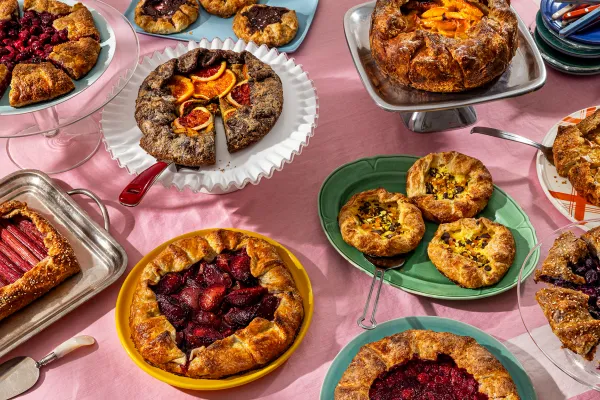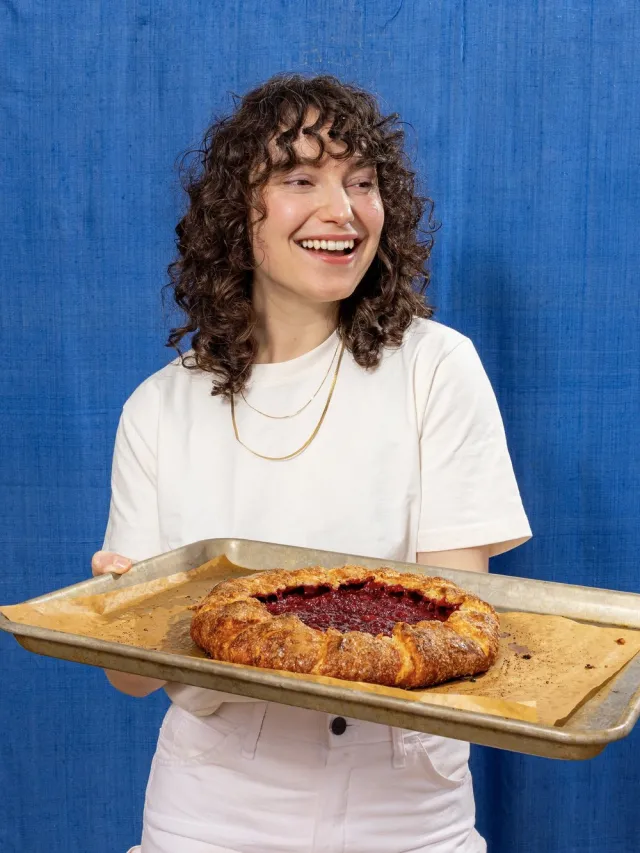How Fear of Pastry Became My Flour Power
Smith Quarterly
A deep dive into galette dough yields a debut cookbook

Open-faced pies had not been explored in depth via a single-subject cookbook until Firkser’s Galette! was published this year. Photograph by Jessica Marx
Published November 17, 2025
I used to be afraid of galette dough. I was timid when rubbing butter into flour. Trepidatious when drizzling in water to bring it all together. And then other times overzealous, kneading the pastry too much or splashing in extra liquid. Sometimes I’d rush through the process in an effort to make sure the butter stayed cold and miss a step, or I’d take too long focusing on technique and the fat would melt. I tried switching to machines, but they turned the dough into a lumpy paste. Some of those early pastry crusts turned out tough, others so delicate they barely held together. But today I could probably make one blindfolded.
When I feel I need to learn something, I obsess. As a teen, I wanted to design and sew my own clothes. I’d sit in my parents’ basement for hours on end while my sewing machine ripped through muslin. When I learned that the final for a Smith Shakespeare class would involve identifying quotes from several plays and sonnets, I read them aloud until I’d memorized everything on the syllabus. (To this day I can recite Sonnet 116 if you’d care to hear it.)
Learning to cook was a similar process. I watched the Food Network whenever I had spare time and devoured cookbooks and food magazines. When I found a dish I wanted to perfect, I’d make it over and over until I knew the method by heart. When I realized I could potentially turn this pastime into a career, I started a cooking blog—the Substack newsletter of the time—with an editorial calendar of strict publishing dates.
I used that blog to generate writing samples and start cobbling together gigs in food media. But did I want to focus on writing, editing, or social media? Did I want to produce restaurant reviews or develop recipes? Edit cookbooks? Should I become a go-to source for a certain culinary technique, like sourdough baking or fermentation or vegetarian cooking? If I wanted to cook and not stare at a computer for most of the day, should I focus on food styling or culinary production? The world was in fact so broad, and my areas of interest just as wide-ranging, I found I couldn’t bring myself to focus on just one thing. I did my best to do a little of everything. And whenever I felt I needed to brush up in a particular area, I’d lock into obsession mode: Once, I bought a rotisserie chicken every night for a month to practice my carving skills.
Suffice it to say I’m not a pastry chef. We’ve already established that I certainly was no prodigy when it came to dough. So how did I wind up writing a book all about galettes? Obsession.
Though it may seem like everyone and their mother has a cookbook, selling one is no small feat. It’s not enough to have a good idea and talent. To pique a publisher’s interest today, authors should have already cultivated a large social media following via their business or personal brand. For those who haven’t, a good way to write a cookbook is to highlight a single subject.
One could wax poetic about anything, I suppose, but to actually fill a book’s worth of pages with recipes centered on one topic is daunting. You need to dive deep without being repetitive. The subject should feel worthy of inspiring dozens of recipes, and those recipes should all be attainable to home cooks. (Because at the end of the day, who’s really buying these books?) The answer was clear: galettes. The open-faced pie was often celebrated on popular recipe platforms, but unlike cookies, cake, or traditional pie, it had not yet been explored in depth via a single-subject cookbook. Surprisingly, getting this particular book deal was a straightforward, painless process. Writing the recipes, on the other hand, required obsession.
I’d never immersed myself so firmly in a subject before. Where in previous projects I might’ve been told by an editor to trim additional analysis, I suddenly had an entire chapter to dedicate to galettes that celebrated stone fruit. And another one to berries. And another to root vegetables. Before this book, being a jack-of-all-trades with small pockets of experience in multiple areas was helpful to my work. But once I got into the kitchen to work on the book, the only thing that mattered was galettes.
I started, of course, with the dough. A galette is essentially half crust and half filling, so anyone who cooked from my book would need to make dough. I wanted to develop a recipe that used just a handful of kitchen staples and didn’t require any special equipment; I wanted to show how anyone could make this with a bowl and their hands (and eventually, something to roll out the dough with). The language needed to be clear and concise and enlightening, like when a great teacher explains something complex and it finally makes sense.
Once that recipe was in a decent place, it went to over 60 recipe testers, most of whom had feedback that I ended up incorporating into the final draft. (You’ll see there is now a method for making dough with a food processor: One tester swore he’d never bother making it by hand knowing it was possible in the machine, and that scared me enough to give readers the option.) There were times throughout the process when I wanted to start from scratch. I wrote and deleted and rewrote. I don’t want to think about how many sticks of butter I unwrapped over the past two years. But now, as I hold my book, Galette!: Sweet and Savory Recipes as Easy as Pie, and see others baking from it, I feel the obsession was worth the multiple new gray hairs. Mostly.
Journalist and author Malcolm Gladwell has said it takes 10,000 hours to master a skill. I haven’t timed it, but I know I’ve made well over 100 batches of my final galette dough recipe (it’s titled A Good Crust). At a recent Q&A, a young woman told me she’d tried many recipes for pastry dough and was excited to try mine now that the book was out. But, she shared, she had not yet found one that worked better than the version she’d made up in her head and baked countless times. Why do you think that is? I told her she was probably a genius when it comes to pastry, but I think the answer really lies in the obsession.
Rebecca Firkser ’15 is a Brooklyn-based writer and cook. Her recipes and writing have appeared in Bon Appétit, Food52, TASTE, Eater, and New York Magazine’s The Strategist, among others. She writes the Substack newsletter Nickel & Dine, celebrating budget-friendly recipes. Galette! is her first cookbook.
